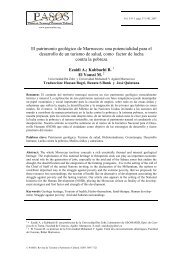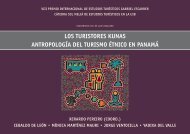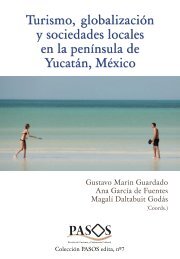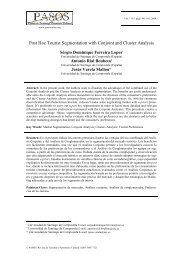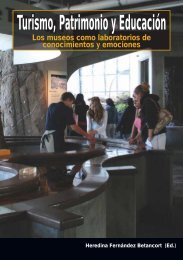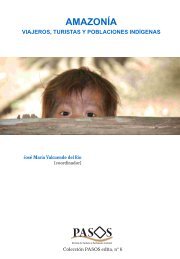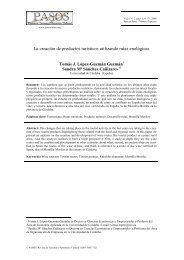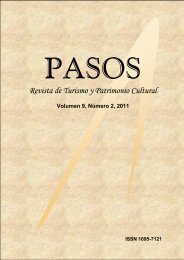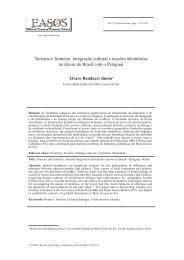Full Journal - Pasos
Full Journal - Pasos
Full Journal - Pasos
Create successful ePaper yourself
Turn your PDF publications into a flip-book with our unique Google optimized e-Paper software.
92 Repositioning of Barcelona’s Image in the Light of a Redefinition of the Urban Tourism Planning Model<br />
––<br />
Incorporation of new technology in managing<br />
city tourism<br />
––<br />
Introducing new business concepts<br />
––<br />
Organisational integration and flexibility<br />
2.1.1. City sustainability<br />
Regarding city sustainability, the development<br />
of sustainable tourism in an integrated<br />
process in which social, economic and environmental<br />
factors are interrelated by the agents<br />
who manage them (Sancho, 2007). Each city<br />
must therefore choose its own path to sustainability<br />
(Bariol, 2010), depending on the needs in<br />
each urban development life cycle. Sustainability<br />
is based on:<br />
––<br />
Economic viability. Using population wealth<br />
indicators ensures the city economy is most<br />
profitable at any given moment and, in the<br />
case of tourist cities, that tourism development<br />
fosters economic development for society<br />
as a whole.<br />
––<br />
Socio-cultural viability. Citizens get visible<br />
quality of life in terms of training, quality<br />
jobs, health, housing, green spaces, culture,<br />
infrastructure, facilities and conservation of<br />
their cultural identity.<br />
––<br />
Environmental viability. Tourism development<br />
must be based on exploitation of an area<br />
in which regeneration outstrips use. In other<br />
words, tourism must put right any environmental<br />
damage caused by tourists’ land use.<br />
Three key issues need solving in connection<br />
with this triple sustainability. The first concerns<br />
the model’s long-term economic viability.<br />
The viability of tourism projects and rehabilitation<br />
work has been effectively tackled in those<br />
French cities (some 2,500 municipalities) and<br />
world ones (among them, Amsterdam, Brussels,<br />
New York, and Tokyo) that have levied a tourism<br />
tax on overnight hotel stays. The approach has<br />
created standing funds earmarked for ongoing<br />
development of local tourism. It is true that<br />
such taxes are solely borne by hotels (hoteliers<br />
complain it makes their accommodation more<br />
expensive while leaving other tourism products<br />
unscathed). On the other hand, public spending<br />
on tourism will not rise over the medium term<br />
given the economic crisis. More advanced tourist<br />
cities will have to balance contributions in this<br />
area. Cities that do not levy a tax on tourist<br />
hotel stays are forced to fund tourism from citizens’<br />
taxes, who end up paying for the dubious<br />
privilege of sharing city facilities with tourists.<br />
Whichever way one looks at it, a direct tax on<br />
tourists yields a balanced solution over the short<br />
term for most cities.<br />
A second key issue linked to sustainability<br />
is the link between ‘carrying capacity’ and ‘ecological<br />
footprint’. An area’s carrying capacity is<br />
the extent to which peak demands can be met<br />
without these seriously affecting the area’s<br />
functioning (Ingurumena, 2003). The ecological<br />
footprint is the amount of resources an area<br />
requires to meet the demands made upon it by<br />
lifestyle and consumption habits (Rees, 1992;<br />
Wackernagel, 1994; 1996).<br />
Some pioneering cities, of which Venice is<br />
a shining example, have established automatic<br />
measures to stop tourism crossing certain<br />
thresholds. However, as with the previous issue,<br />
knowledge of the carrying capacity of main streets,<br />
the most visited sights and neighbourhoods<br />
is key to achieving city sustainability, which is<br />
the main aim of local Agenda 21 plans.<br />
The third issue regarding the planning of<br />
competitive, sustainable tourist cities concerns<br />
‘resilience’, which means a city’s ability to reinvent<br />
itself and strike a new balance after<br />
alteration by external agents (Alberti et al,<br />
2003). The UN’s World Tourism Organization,<br />
UNWTO, set up a Tourism Resilience Committee<br />
in 2009 specifically to help tourist economies<br />
face the crisis and to create and pool knowledge<br />
regarding ways of adapting and changing the<br />
tourism model.<br />
2.1.2. Integrated Management and Governance<br />
Apropos management and governance, it<br />
should be borne in mind that city tourism planning<br />
is a system of interconnected functions and<br />
processes to yield quality products and services<br />
for and sustainable management of the urban<br />
community” (Paskaleva-Shapira, 2007). In this<br />
connection, most large European cities have set<br />
up tourism boards (most of which are publiclyrun<br />
but there are some public-private partnerships)<br />
for promoting their respective brand images.<br />
As cities have focused more on this task,<br />
they have largely ignored others such as: creating<br />
tourist products; actively developing human<br />
capital and tourism logistics throughout the city;<br />
exploiting technology; co-ordinating tourism.<br />
Planning economic and financial resources for<br />
long-term city development has been overlooked<br />
completely (Valls, 2004). The way powers are<br />
split between various municipal bodies has led<br />
to poor co-ordination of city tourism planning<br />
and implementation of its strategies and poli-<br />
PASOS. Revista de Turismo y Patrimonio Cultural, 11(1). 2013 ISSN 1695-7121



